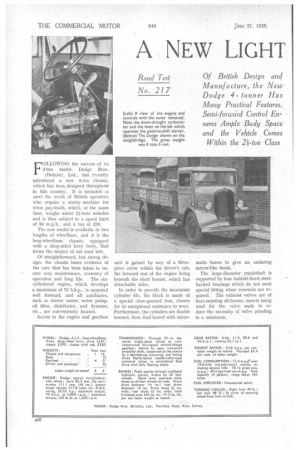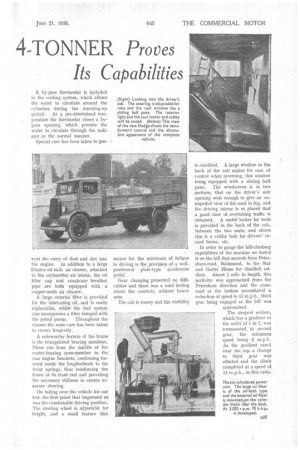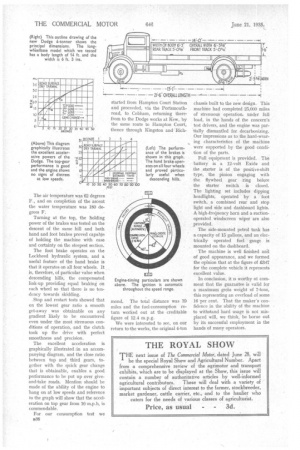ANEW LIGHT
Page 50

Page 51

Page 52

If you've noticed an error in this article please click here to report it so we can fix it.
4-TONNER Proves Its Capabilities
FOLLOWING the success of its 3-ton model, Dodge Bros. (Britain), Ltd., has recently introduced a new 4-ton chassis, which his been designed throughout in this country. It is intended lo meet the needs of British operators who require a sturdy machine for 4-ton pay-loads, which, at the same time, weighs under 21-tons unladen and is thus subject to a speed limit of 30 m.p.h.. and a tax of £30.
The new model is available in two lengths of wheelbase, and it is the long-wheelbase chassis, equipped with a drop-sided lorry body, that forms the subject of our road test.
Of straightforward, but strong design, the chassis bears evidence of the care that has been taken to 'ensure easy maintenance, economy of operation and long life. . The sixcylindered engine, which develops a maximum of 70 b.h.p., is mounted well forward, and all auxiliaries, such as starter motor, water pump, oil filter, distributor, and dynamo, etc., are conveniently located.
Access to the engine and gearbox unit is gained by way of a threepiece cover within the driver's cab, the forward end of the engine being beneath the short bonnet, which has detachable sides.
In order to provide the maximum cylinder life, the block is made of a special close-grained iron, chosen for its exceptional resistance to wear. Furthermore, the cylinders are double reamed, then dual-honed with micro
matic hones to give an enduring mirror-like finish, The large-diameter crankshaft is supported by four babbitt-lined, steelbacked bearings which do not need special fitting when renewals are required. The exhaust valves are of heat-resisting silchrorne, inserts being used for the valve seats to reduce the necessity of valve grinding to a minimum.
A by-pass thermostat is included in the cooling system, which allows the water to circulate around the cylinders during the warming-up period. At a pre-determined temperature the thermostat closes a bypass opening, which permits the water to circulate through the radiator.in the normal manner.
Special care has been taken to pre
vent the entry of dust and dirt into the engine. In addition to a large Duplex oil-bath air cleaner, attached to the carburetter air intake, the oil filler cap and crankcase breather pipe are both equipped with a copper-mesh air cleaner.
A large exterior filter is provided for the lubricating oil, and is easily replaceable, Whilst the fuel system also incorporates a filter integral with the petrol pump. Throughout the chassis the same care has been taken to ensure longevity.
A noteworthy feature of the frame is the triangulated bracing members. These run from the middle of the centre-hearing cross-member to the rear engine brackets, continuing forward inside the longitudinals to the front springs, thus reinforcing the frame at its front end and providing the necessary stiffness to ensure accurate steering.
On taking over the vehicle for our test, the first point that impressed us was the comfortable driving position. The steering wheel is adjustable for height, and a small feature that
makes for the minimum of fatigue in driving is the provision of a wellpositioned plate-type accelerator pedal.
Gear changing presented no difficulties and there was a solid feeling about the controls, without heaviness.
The cab is roomy and the visibility is excellent. A large window in the back of the cab makes for ease of control when reversing, this window being equipped with a sliding half pane. The windscreen is in two _sections, that on the driver's side opening wide enough to give an unimpeded view of the road in fog, and the driving mirror is so placed that a good view of overtaking traffic is obtained. A useful locker for tools is provided in the back of the cab, between the two seats, and above this is a cubby hole for drivers' record forms, etc.
In order to gauge the hill-climbing capabilities of the machine we tested it on the hill that ascends from Petersham-road, Richmond, to the Star and Garter Home for disabled soldiers. About I mile in length, this acclivity was approached from the Petersham direction and the crossroad at the bottom necessitated a reduction of speed to 15 m.p.h., third gear being engaged as the hill was approached.
The steepest section, which has a gradient in the order of 1 in 7, was surmounted in second gear, the minimum speed being 8 m.p.h. As the gradient eased near the top, a change to third gear was effected and the climb completed at a speed of
14 m.p.h., in this ratio. •
The air temperature was 62 degrees F., and on completion of the ascent the water temperature was 180 degrees F.
Turning at the top, the holding power of the brakes was tested on the descent of the same hill and both hand and foot brakes proved capable of holding the machine with ease and certainty on the steepest section.
The foot brake operates on the Lockheed hydraulic system, and a useful feature of the hand brake is that it operates on all four wheels. It is, therefore, of particular value when descending hills, the compensated link-up providing equal braking on each wheel so that there is no tendency towards skidding.
,Stop and restart tests showed that on the lowest gear ratio a smooth get-away was obtainable on any gradient likely to be encountered even under the most strenuous conditions of operation, and the clutch took up the drive with perfect smoothness and precision.
The excellent acceleration is graphically illustrated in an accompanying diagram, and the close ratio between top and third gears, together with the quick gear change that is obtainable, enables a good performance to be put up over giveand-take roads, Mention should be made of the ability of the engine to hang on at low speeds and reference to the graph will show that the acceleration on top gear from 10 m.p.h. is commendable.
started from Hampton Court Station_ and proceeded, via the Portsmouthroad, to Cobham, returning therefrom to the Dodge works at Kew, by the same route to Hampton Court, thence through Kingston and Rich
mond. The total distance was 19 miles and the fuel-consumption return worked out at the creditable figure of 12.4 m.p.g.
We were interested to see, on our return to the works, the original 4-ton chassis built to the new design. This machine had completed 25,000 miles of strenuous operation, under fall load, in the hands of the concern's :test drivers, and the engine was partially dismantled for decarbonizing. Our impressions as to the hard-wearing characteristics of the machine were supported by the good condition of the parts.
Full equipment is provided. The battery is a 12-volt Exide and the starter is of the positive-shift type, the pinion engaging with the flywheel gear ring before the starter switch is closed. The lighting set includes dipping headlights, operated by a foot switch, a combined rear and stop light and side and dashboard lights. A high-frequency horn and a suctionoperated windscreen wiper are also provided.
The side-mounted petrol tank has a capacity of 15 gallons, and an electrically operated fuel gauge is mounted on the dashboard.
The machine is well finished ana of good appearance, and we formed the opinion that at the figure of £347 for the complete vehicle it represents excellent value.
In conclusion, it is worthy of comment that the guarantee is valid for a maximum groin weight of 7-tons, this representing an overload of some 16 per cent. That the maker's confidence in the ability of the machine to withstand hard usage is not misplaced will, we think, be borne out by its successful employment in the hands of many operators.




























































































